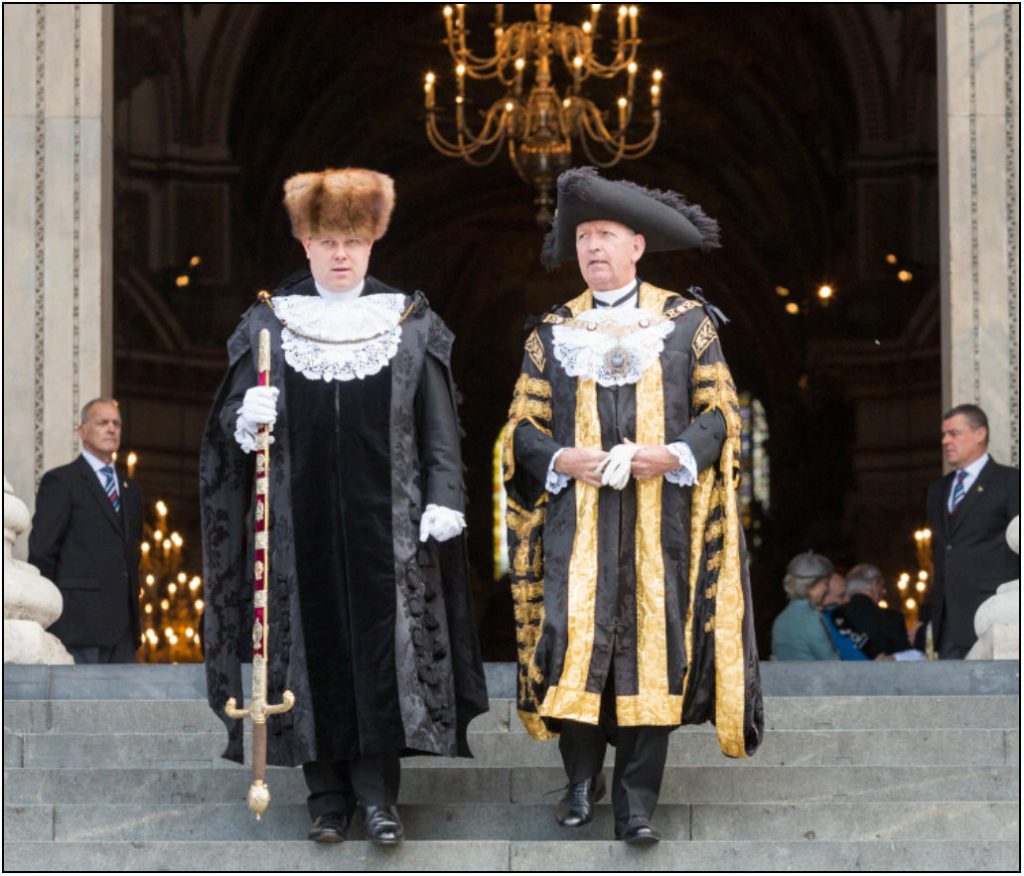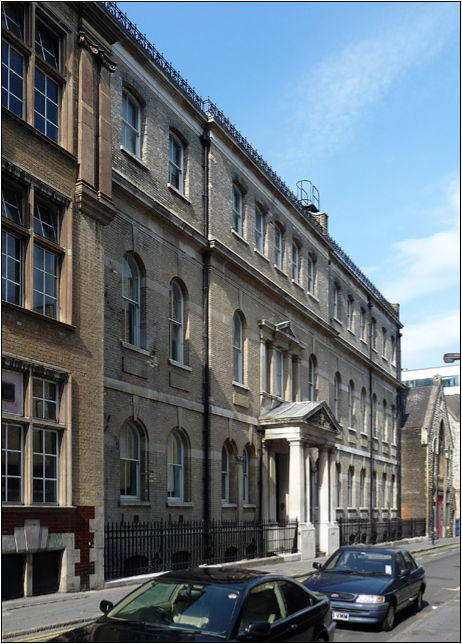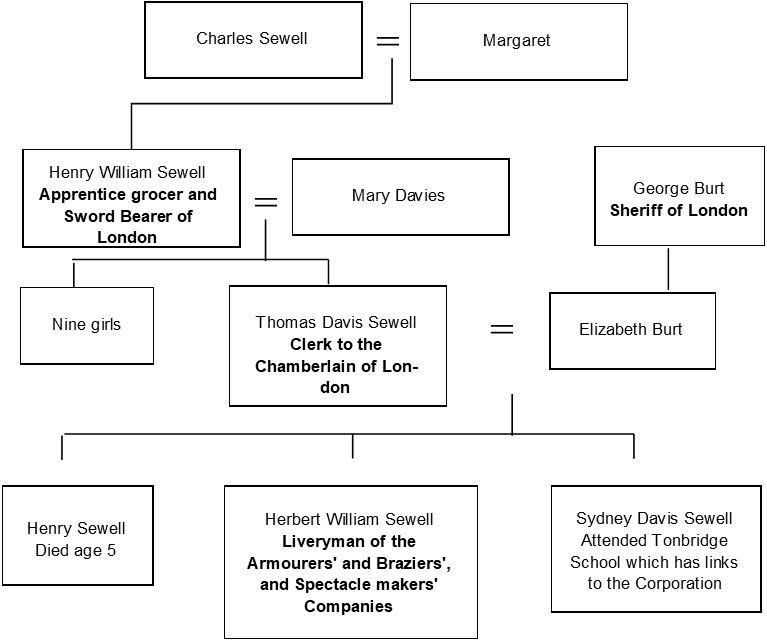By Ian Sewell
This article was published in the April 2019 edition of Soul Search, the Journal of The Sole Society
Tony Storey, our Research Co-ordinator spotted the following notice in the Shoreditch Observer for 28 May 1915.
Lieutenant H W Sewell
Mr Herbert William Sewell (surviving son of Colonel T Davies Sewell) who is a liveryman of the Armourers’ and Braziers’, and Spectaclemakers’ Companies, after 4 months duty with the Expeditionary Force, has been preferred to a Lieutenancy in the Royal Engineers as a result of his many years’ experience of civil engineering.
Tony passed the information onto Ian Sewell, our Research Co-ordinator for the Sewell surname, and copied me in on the email. In his files Ian had Herbert Sewell’s military records, his brother’ Sidney’s obituary and some information about their father and grandfather showing strong links to the Corporation of London as you will see overleaf.
For those, like me, who know nothing about the City of London Corporation, it is the municipal governing body of the City of London. It includes the Lord Mayor, the Court of Aldermen, the Court of Common Council, and the Freemen and Livery of the City. The rights and privileges of the City of London are enshrined in the Magna Carta.
There is a family tree at the end of the article.
Henry William Sewell
Henry William Sewell was the grandfather of Lieutenant H W Sewell and was the second son of Charles and Margaret Sewell born around 1796. He married Mary Davis on the 20 February 1830 St Giles without Cripplegate, City of London. The family links to the Corporation of London were already apparent and Henry was apprenticed 1 April 1847 to James Holder, Grocer of London. On the 1871 census, just before his death the following year, his occupation is given as Sword Bearer of London.
The Sword Bearer of London is one of three ceremonial officers appointed by the Court of Aldermen and has been in existence since the 14th Century. The role is first mentioned in 1419 when issues about the position’s job description came up. At that time it was recorded that the Lord Mayor should have, at his own expense, someone to bear his sword before him: …a man well-bred (one who knows how in all places, in that which unto such service pertains, to support the honour of his Lord and of the City).

Thomas Davis Sewell
Thomas Davis Sewell was Henry’s second child and was baptised
22 October 1832 in Old Street,
St Pancras, the only son out of Henry’s ten children. He married Elizabeth Burt in 1871, whose father George Burt, was one of the Sheriffs of London again, a role within the Corporation of London. Following his father into the Corporation, Thomas’ occupation is given as the Clerk of the Chamberlain of London. The Chamberlain of London is the financial adviser, accountant, receiver and paymaster and is responsible for the City of London’s local and private / trust funds. He is responsible for making the arrangements for the investment of City of London and other funds and is one of the three official trustees. The clerk assists him in all these tasks. By 1901 Thomas’ occupation is given as retired Colonel and Newspaper proprietor and some research shows that in addition to his position in the Corporation of London he also was involved in the Royal London militia where he was promoted to Major in 1881, and in 1886 to Lt Col in 2nd Tower Hamlets (East London) Engineer Volunteers. This link to engineering was the key to the futures of his two sons.
Herbert William Sewell
Herbert William Sewell was the second son of Thomas, the eldest Henry died 1878 aged 5, born 11th June 1879. He was educated at the City of London School and at Finsbury Technical College (the first ever Technical College) and was apprenticed 1896 to 1899 Marine Engine Works of Messrs Maudsley Sons & Field, which specialised in marine steam engines. From 1899 to 1900 he was as engineer in ships before holding various posts in drawing offices including Mains Superintendent for Cleveland & Durham County Elec Power Company. In 1903 he secured an appointment as mains superintendent to the Cleveland and Durham County Electric Power Co, with whom he continued until 1912. On 14 May 1906 joined the Institute of Mechanical Engineers in Cleveland & Durham County.
At the outbreak of the 1914-18 war he joined H.M. Forces, and served in the ranks of the Honourable Artillery Co where he served in the trenches until 1915 during which time the piece in the Shoreditch Observer was written.
Being commissioned in the Royal Engineers he built No 1 Power House and other buildings in Calais port. In April 1917 he was appointed Captain of the Calais Dock before being demobilised in 1919. After serving as manager in France for A Mr. W. G. Tarrant for seven years, he joined the staff of Messrs. Merz and McLellan, consulting engineers, of Westminster, and successively filled positions as representative in Newfoundland, plant erector to a tin dredging company, and clerk of the works. His last position, which dated from 1932, was that of assistant transmission engineer to the Central Electricity Board. He died on 14th March 1947.

Sidney Davis Sewell
Sidney Davis Sewell, Herbert’s elder brother, was born in 1874 and went to Tonbridge School which is linked closely with the corporation. On leaving school, he joined the 1st Middlesex R.E. (Vols.), the Regiment to which the School Corps was subsequently attached on its foundation in 1893.

He was promoted Lieutenant in 1894, and Captain 1898. When the South African War broke out he filled an R.E. appointment at Aldershot, which was usually held by a Major of the Regular Army. In 1907 the 1st Middlesex R.E. (Vols.) became the 2nd London R.E. of the Territorial Force and the creation of the O.T.C. brought an end to the direct connection between the Tonbridge School and that Regiment. He was promoted Major in 1910, and placed in command of the 3rd Field Company of the 2nd London R.E. He took the 3rd Field Company to France on January 19th, 1915, and after being engaged in hut building for a time they were employed in digging trenches in the neighbourhood of Ypres. An account that appeared in a London paper told how on the night of February 18th, at the cost of heavy casualties, they succeeded in digging a trench under heavy fire within 25 yards of the German advanced trenches. On that night Major Sewell and three other officers of the Company were killed. He was buried in the Menin Gate Cemetery at Ypres.

